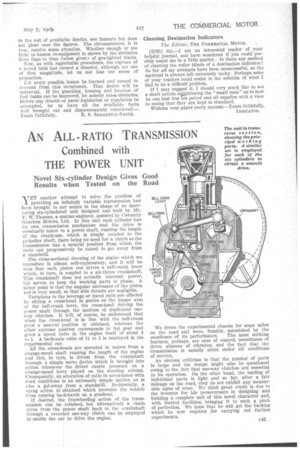AN ALL RATIO TRANSMISSION Combined with THE POWER UNIT
Page 75

If you've noticed an error in this article please click here to report it so we can fix it.
Novel Six-cylinder Design Gives Good Results when Tested on the Road
VET another attempt to solve the problem of X providing an infinitely variable transmission has been brought to our notice in the shape of an interesting six-cylindered unit designed and built by Mr. P. W. Thomas, a marine engineer, assisted by Coventry Gearless Motors, Ltd. In this unit each cylinder has its own transmission mechanism and the drive is eventually taken to a power shaft, running flue length' of. the crankcase, which is simply coupled to the propeller shaft, there being no need for a clutch as the transmission has a neutral position from which the ratio can progressively be raised to get away from a standstill.
The cross-sectional drawing of the engine which we reproduce IS almost self-explanatory, and it will be seen that each piston rod drives a bell-crank lever which, in turn, is coupled to a six-throw crankshaft. This -crankshaft does not actually transmit power, but serves to keep the working parts in phase. A minor point is that the angular movement of the piston rod is very small, so that side thrusts are negligible.
Variations to the leverage or speed ratio are effected by sliding a. cross-head in guides on the longer arm of the bell-crank lever, the cross-head driving the Power shaft through the medium of duplicated oneway clutches. It will, of course, be understood that when the cross-head is in line with the bell-crank pivot a neutral position is obtained, whereas the other extreme position corresponds to top gear and gives a speed ratio in the engine itself of about 3 to 1. A back-axle ratio of 1ir to 1 is employed in the experimental ear.
All the cross-heads are operated in unison from a change-speed shaft running the .length of the engine and this, in turn, is driven from the crankshaft through a simple servo device which is brought into action whenever the driver exerts pressure on a change-speed lever placed on the steering column. Consequently, an alteration of ratio in accordance with road conditions is an extremely simple matter, as is also a get-away from a standstill. Incidentally, a sprag action is obtained which prevents the vehicle from running backwards on a gradient.
If desired, the freewheeling action of the transmission can be retained, but alternatively a chain drive from the power Shaft back to the crankshaft through a reversed one-way clutch can be employed to enable the car to drive the engine. • • We drove the experimental chassis for some miles on the road and were, frankly, astonished by the excellence of its performance. The most striking features, perhaps, are ease of control, smoothness of drive, absence of vibration and the fact that the transmission is equally silent under all conditions of service.
An obvious criticism is that the number of parts is large and the design might also be questioned owing to the fact that one-way clutches are essential to its operation. On the other hand, the loading of individual parts is light and so far, after a fair mileage on the road, they do not exhibit any measurable signs of wear. We think great credit is due to the inventor for his perseverance in designing and building a complete unit of this novel character and, with limited facilities, bringing it to such a pitch of perfection. We hope that he will get the backing which he now requires for carrying out further experiments.






























































































































